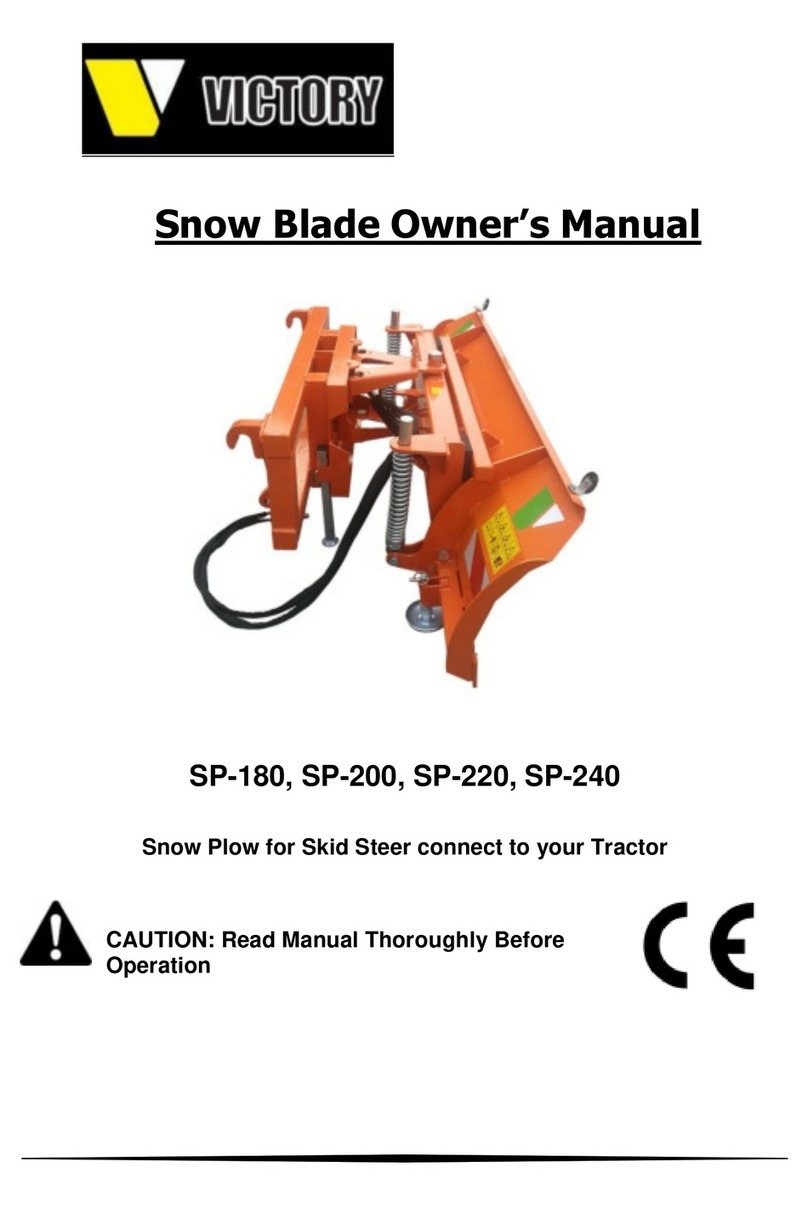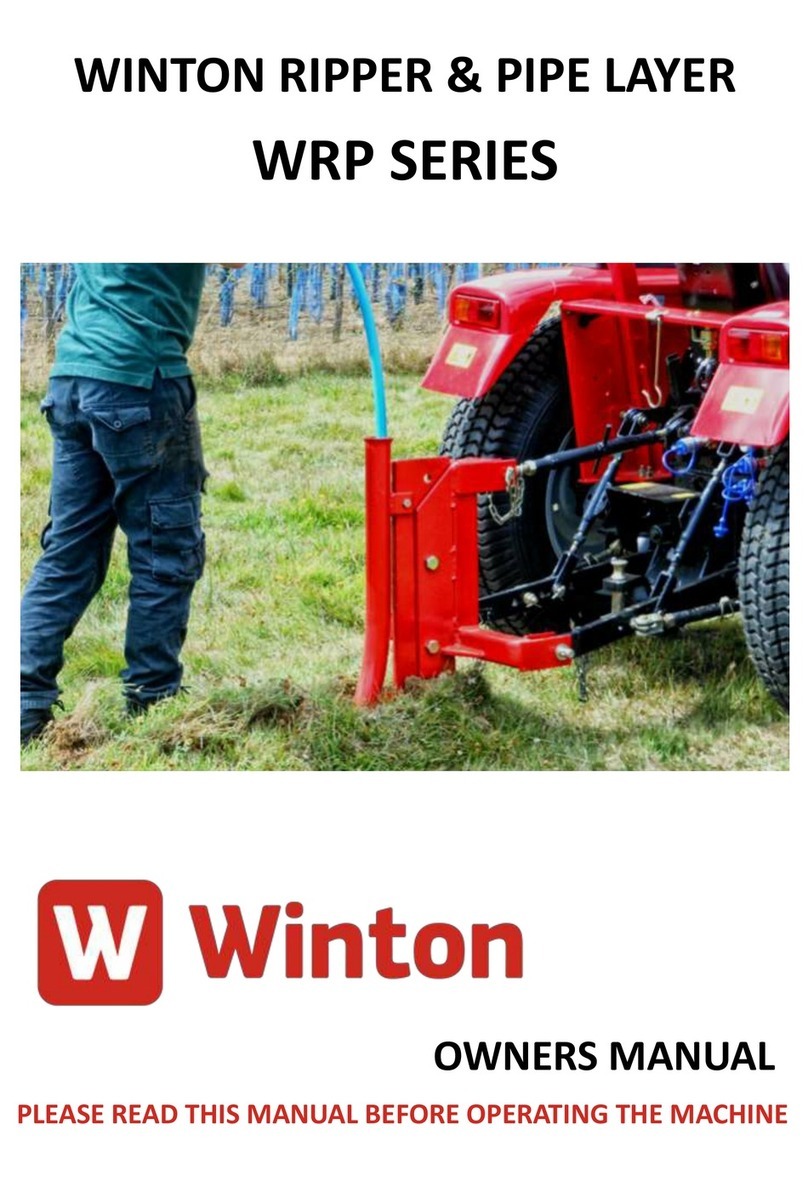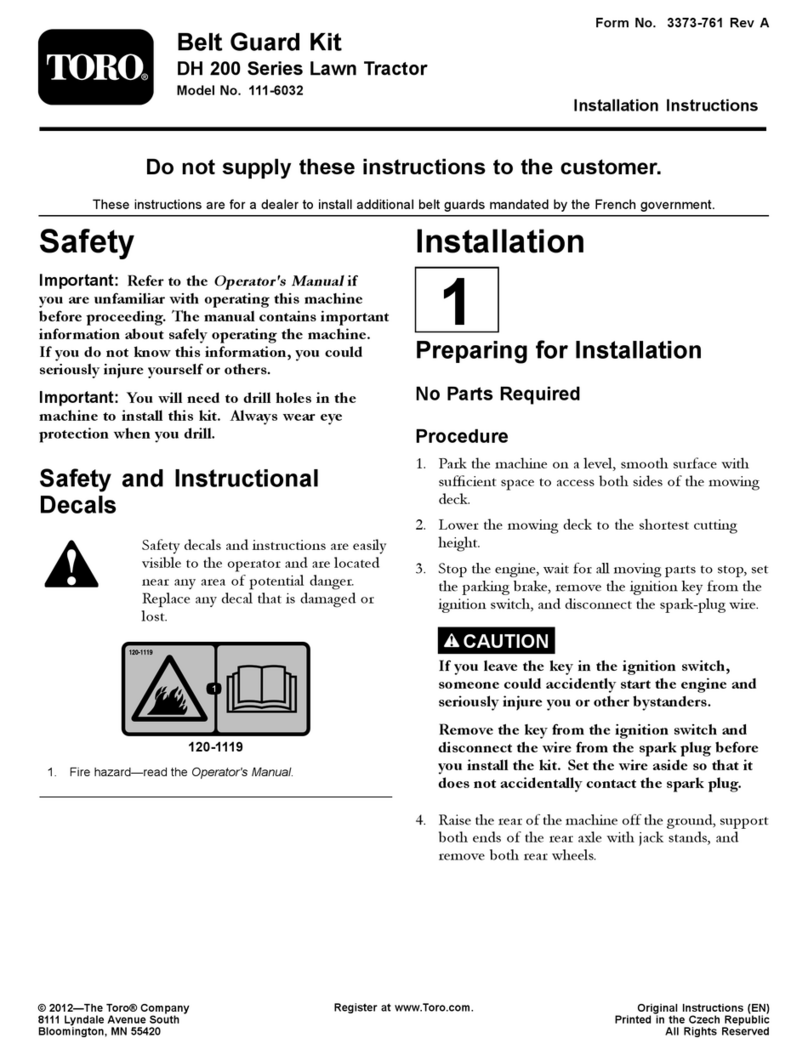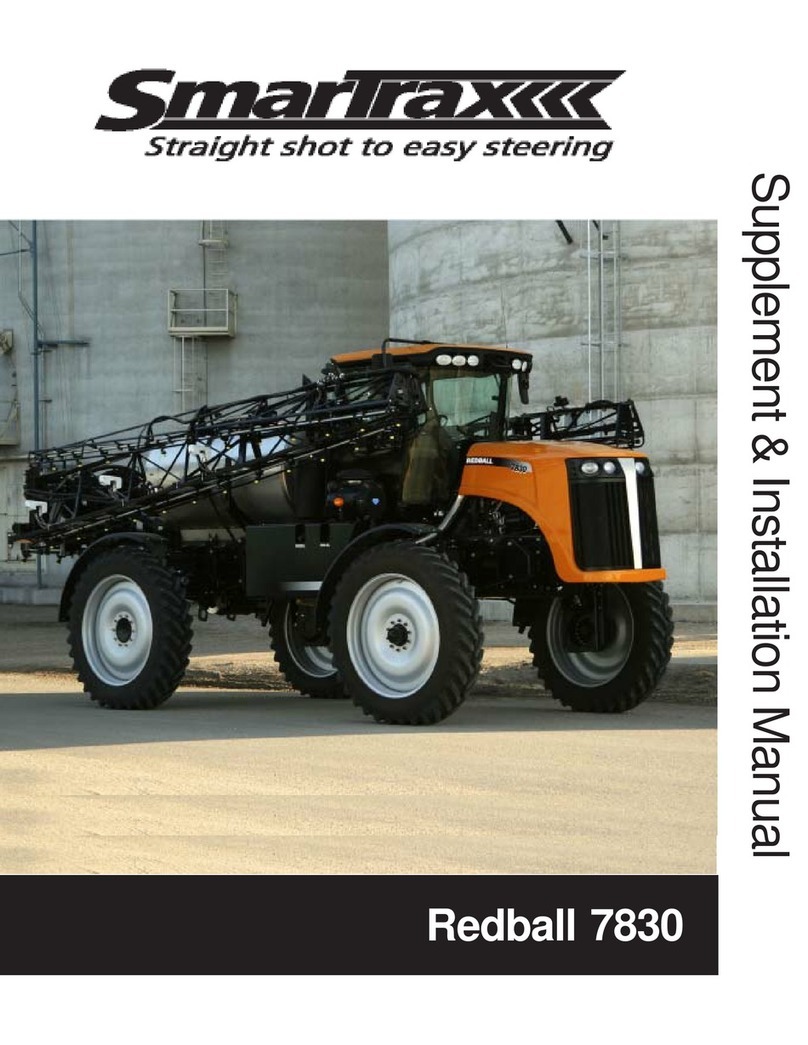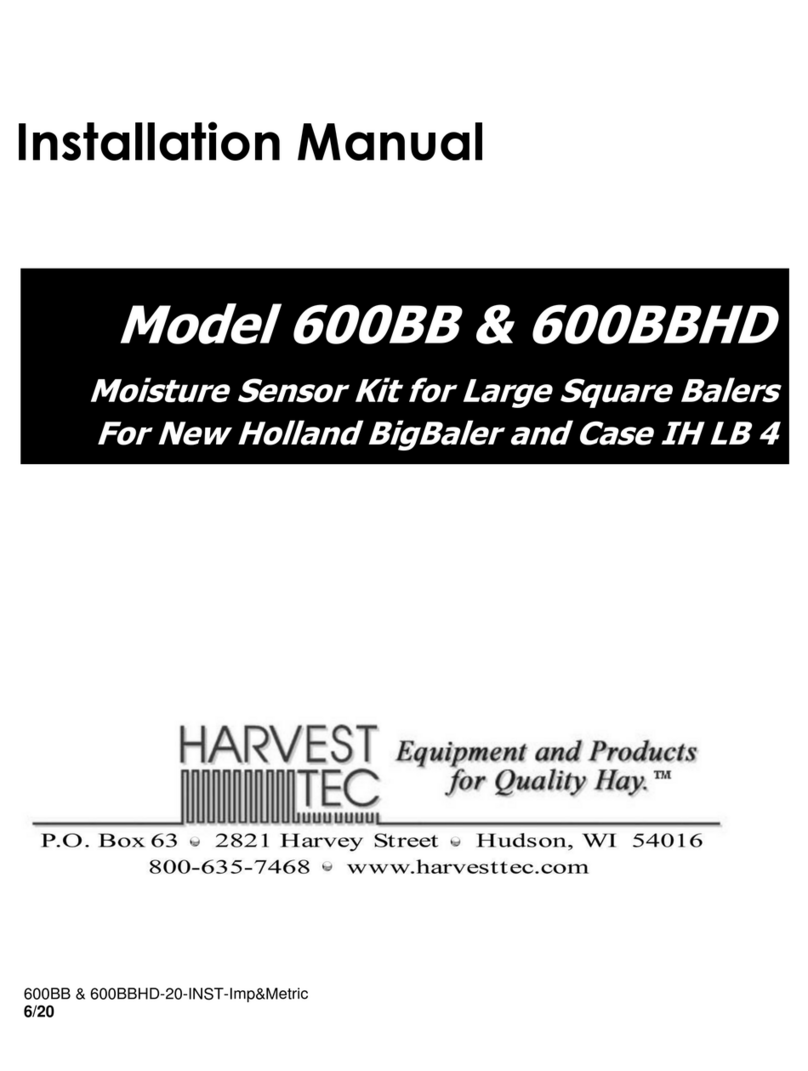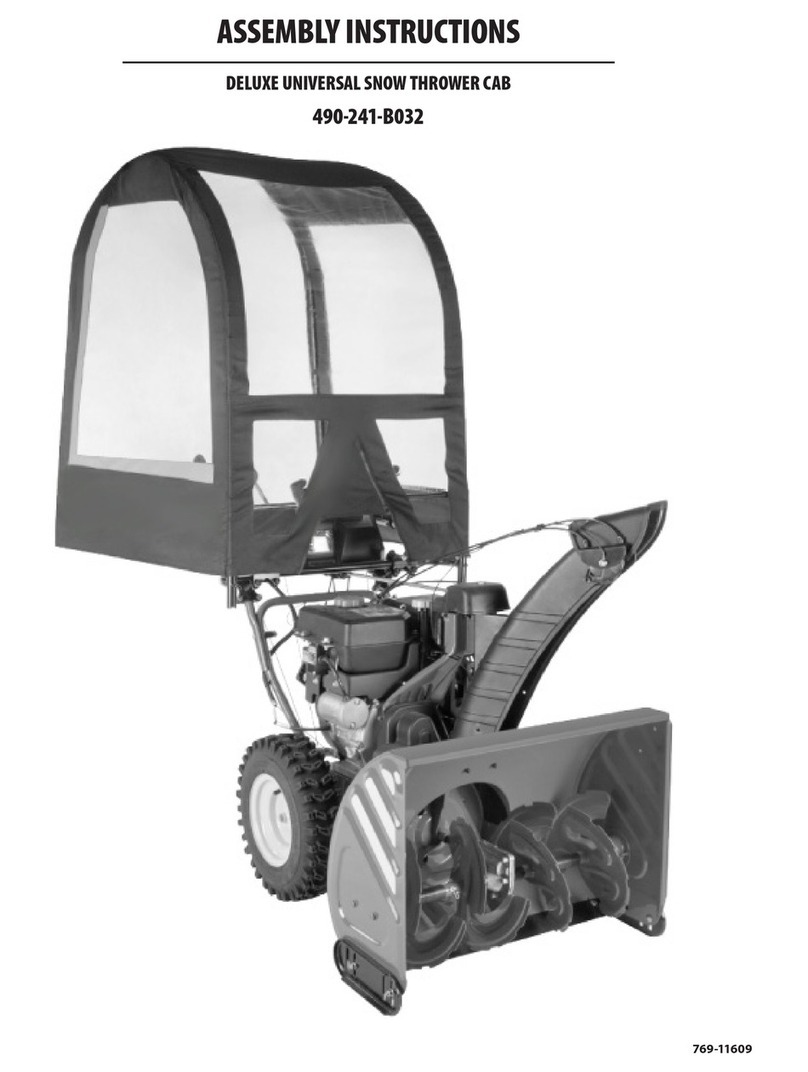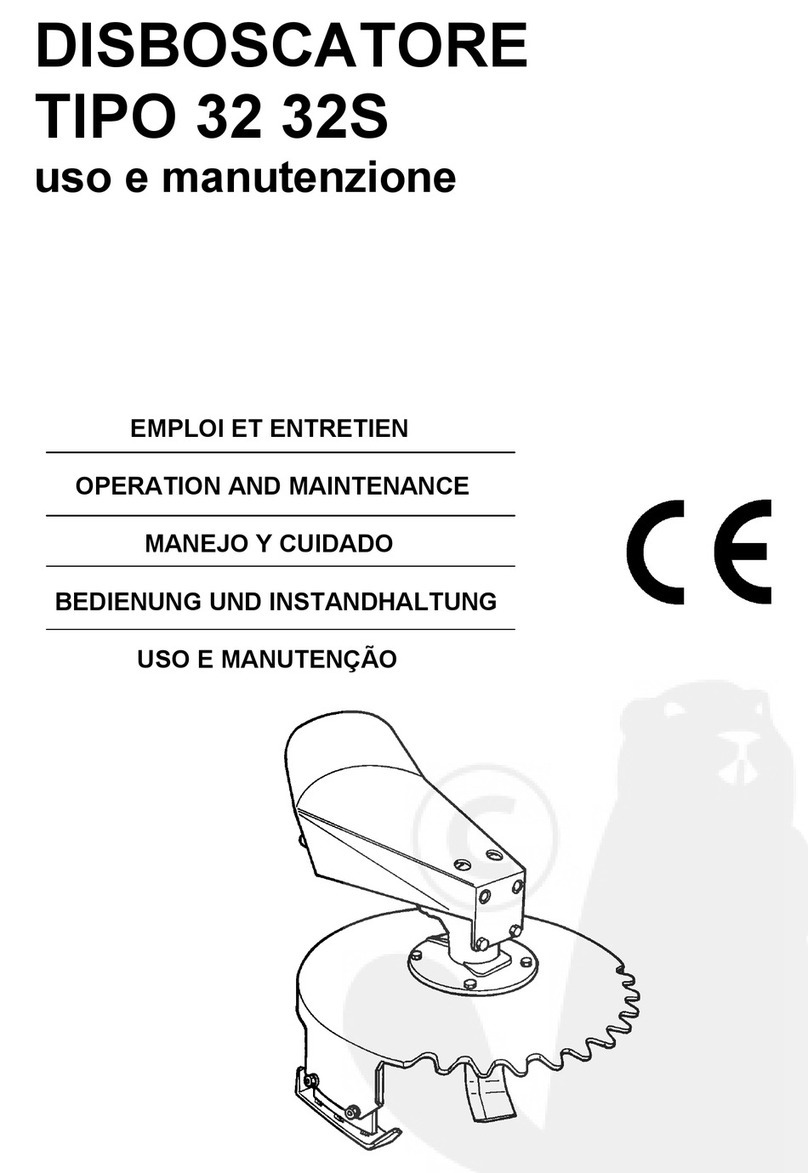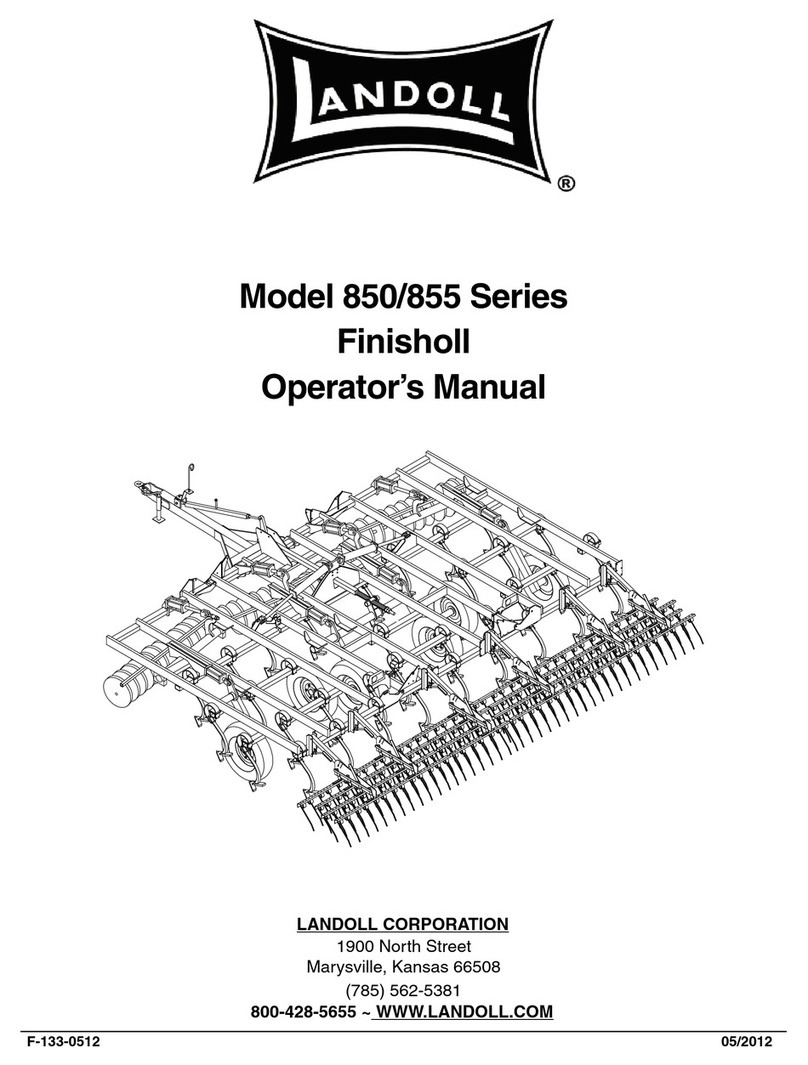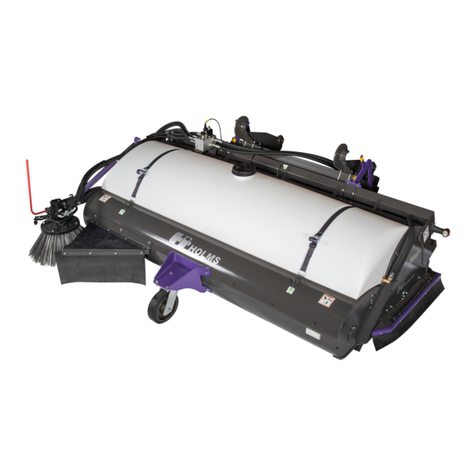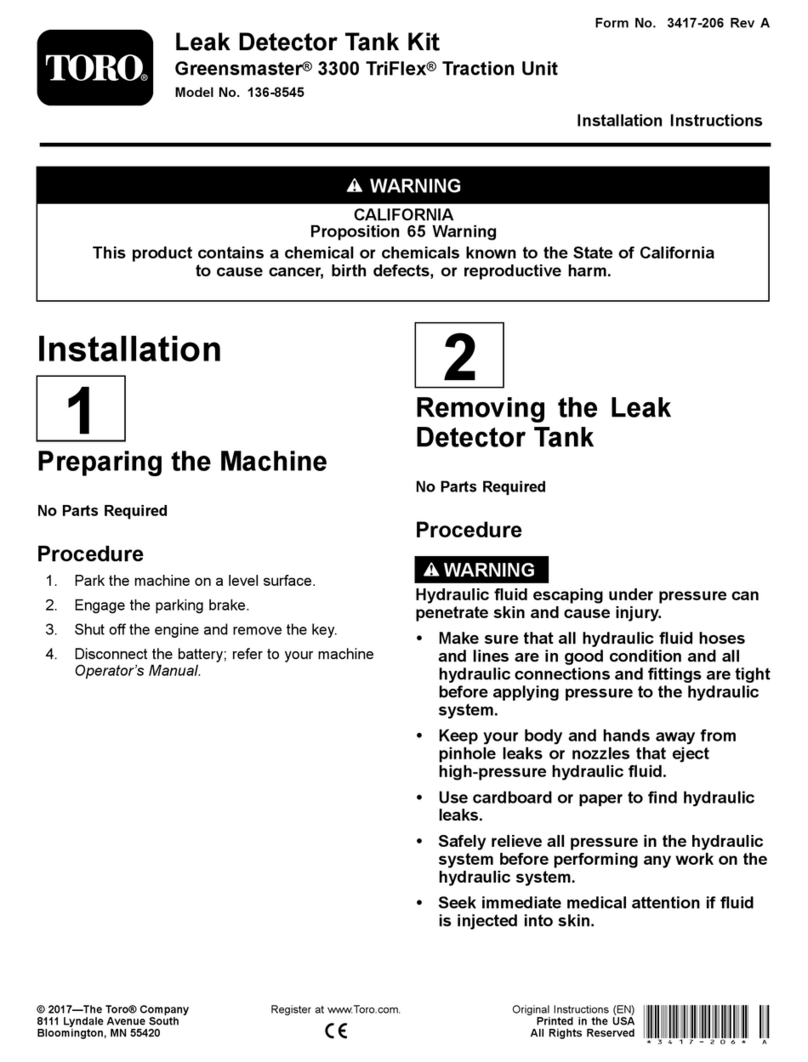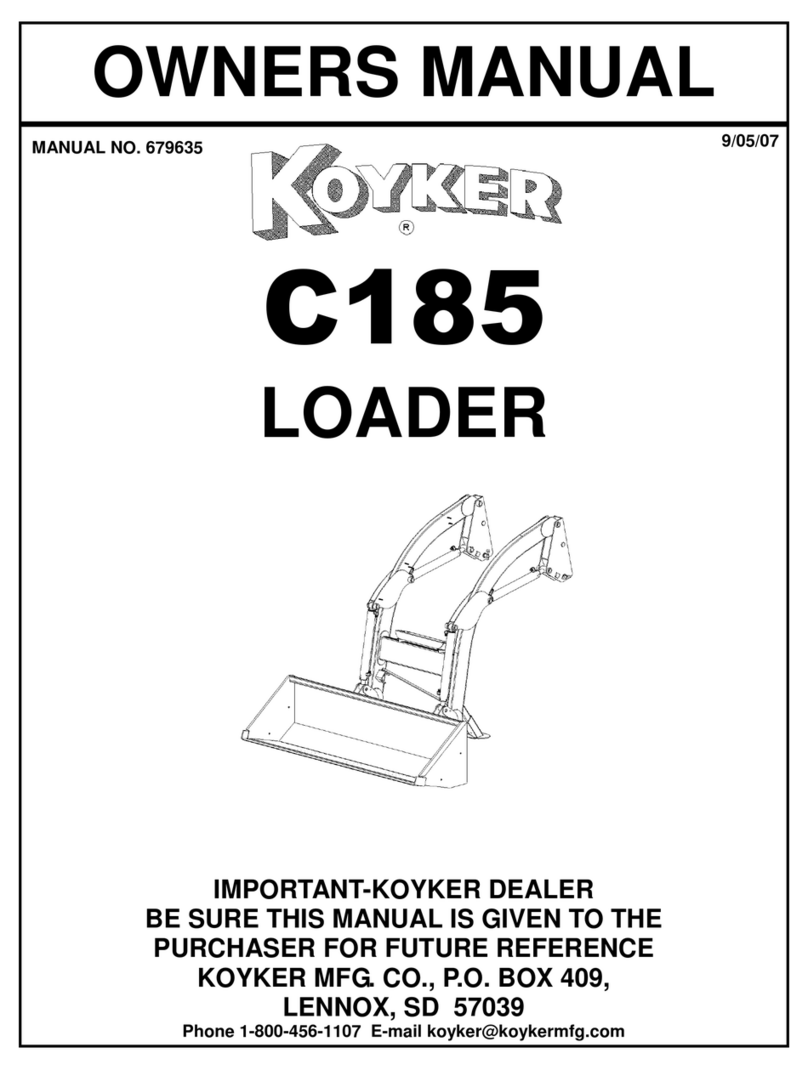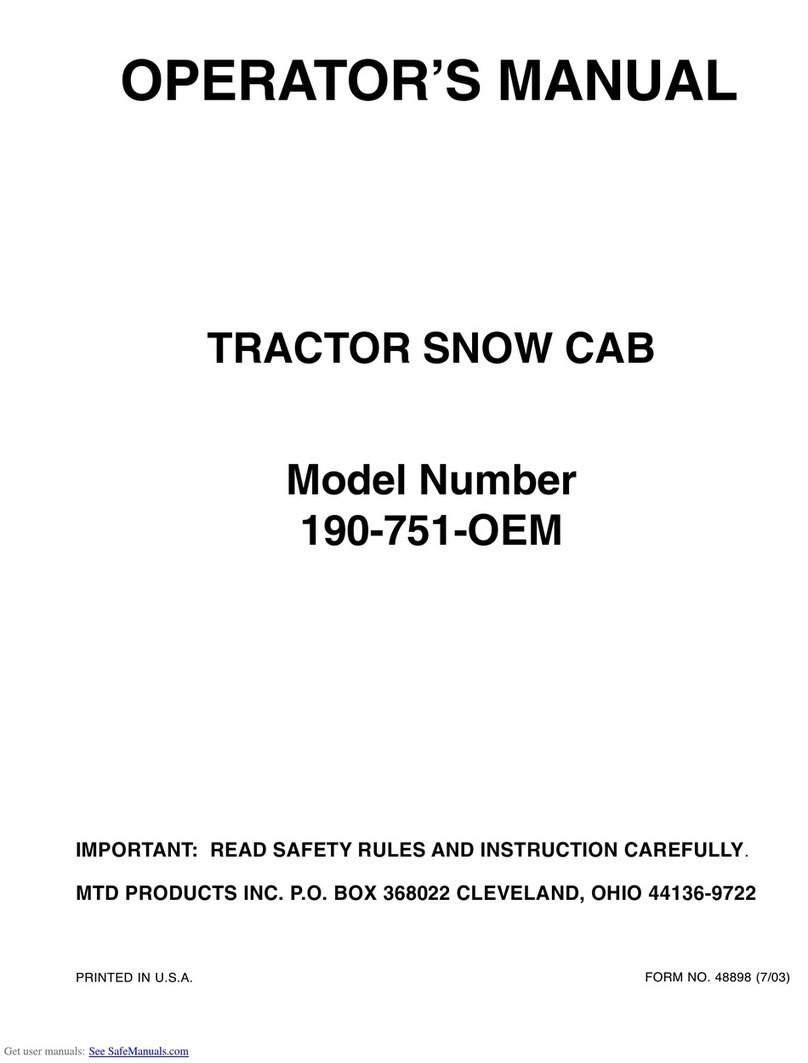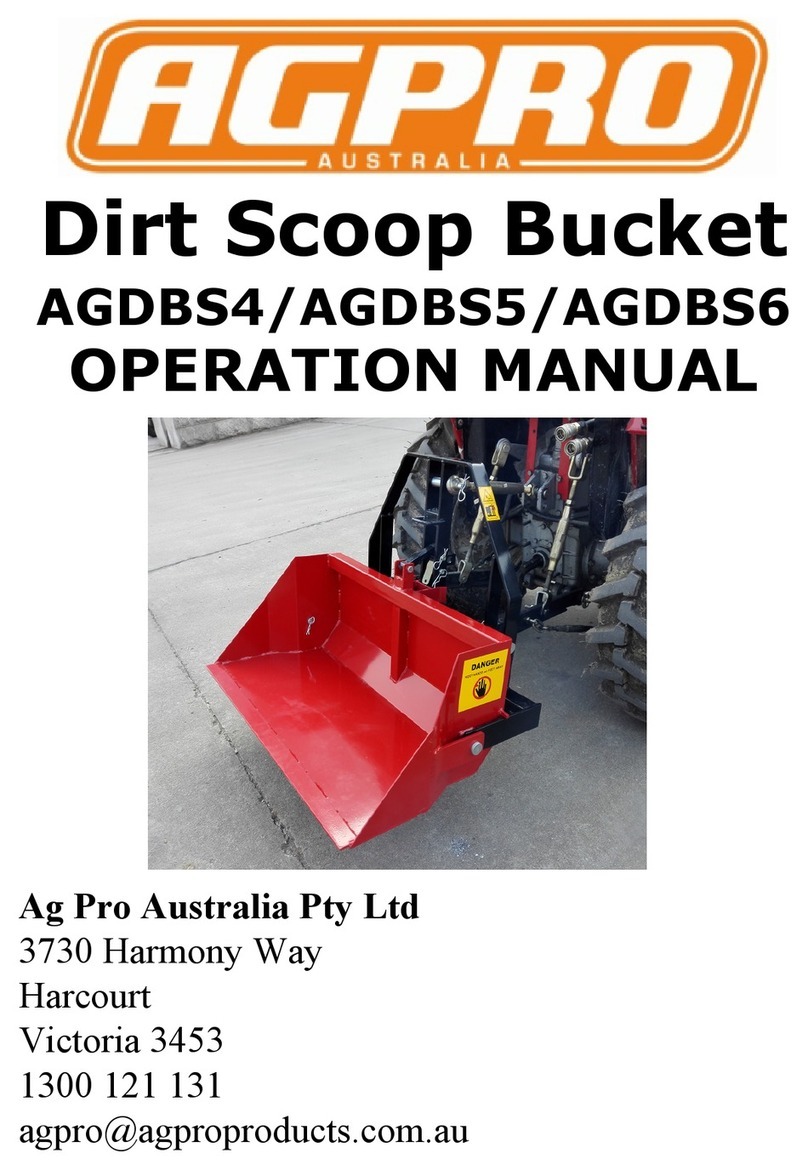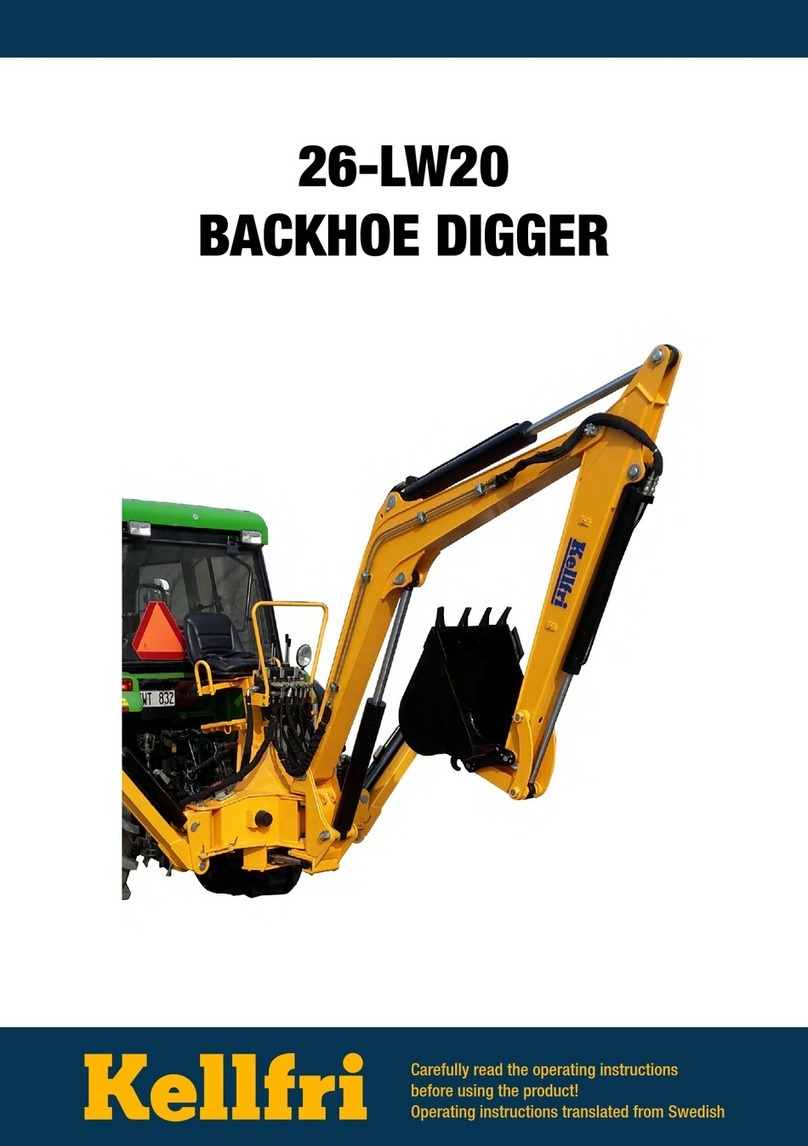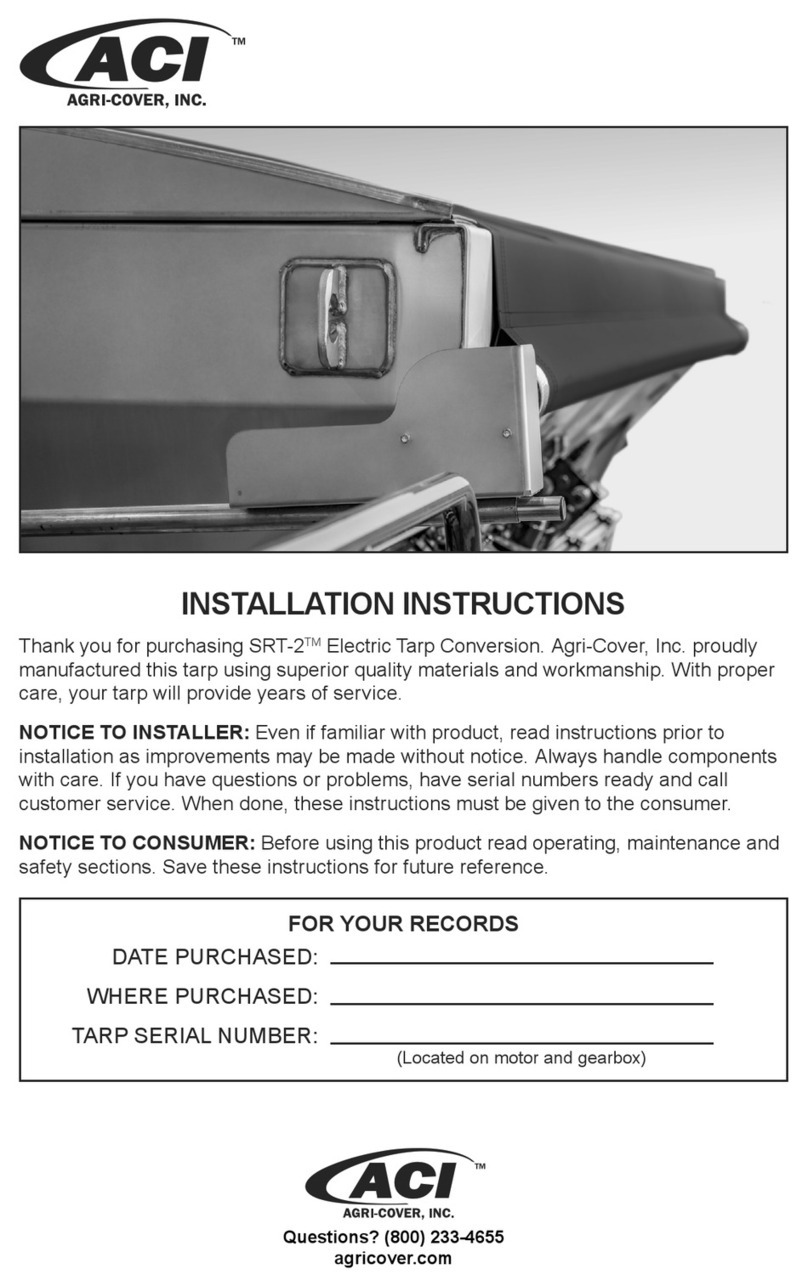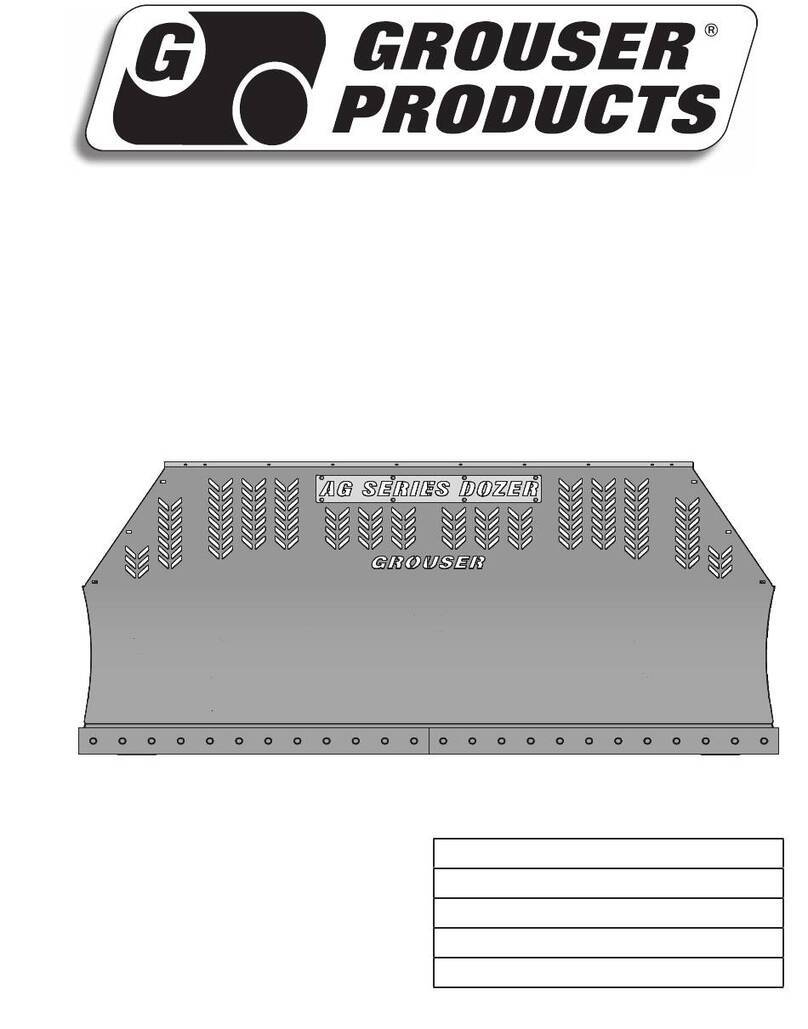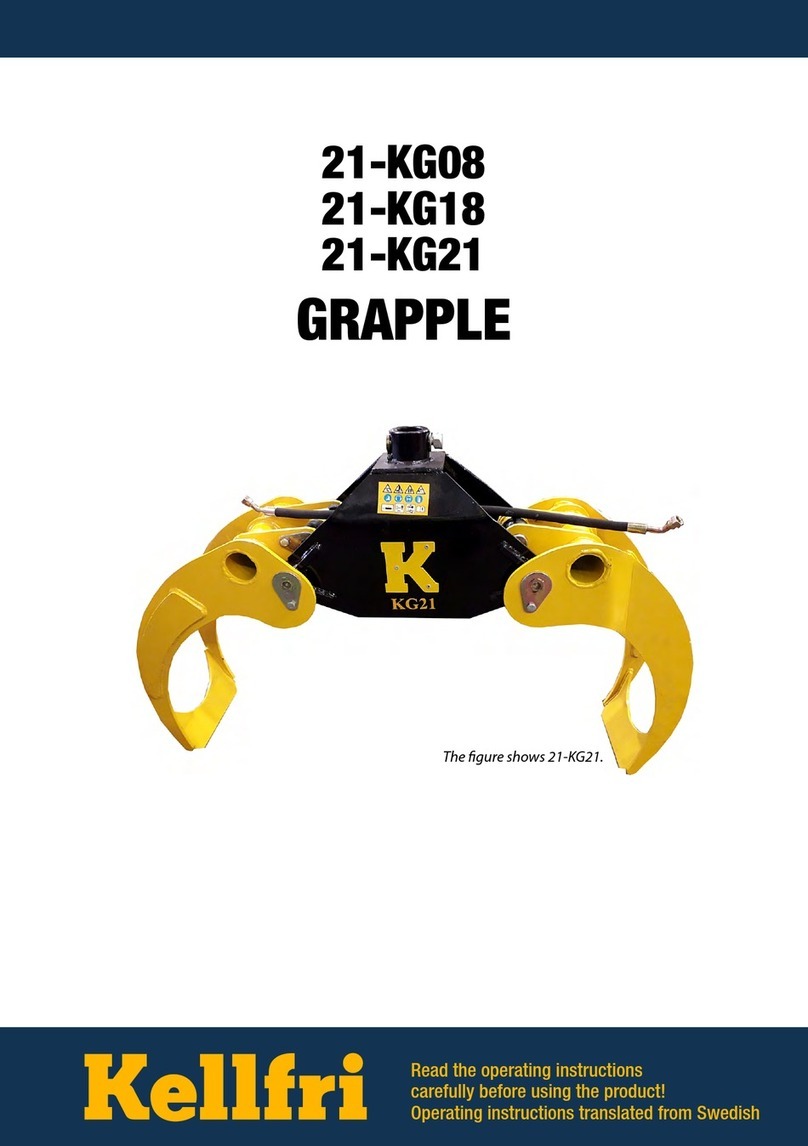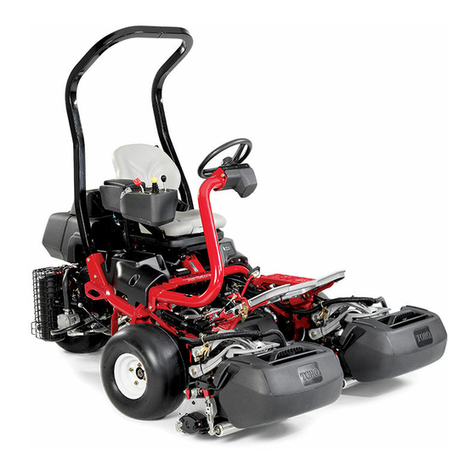Victory BACKHOE Series User manual

Operator's Manual
BACKHOE SERIES
BH6 - BH7 - BH8
VERSION 2.0 - EN 2022

Operator’s Manual Backhoe Series BH - Page 2 of 91 - Version 2.0
COLOPHON
Addresses:
Visitor and Postal address:
65 Pine Ave #857, Long Beach, CA 90802, United States.
Business hours:
Monday-Friday 9:00 am - 5:00 pm
Internet address:
https://etractorimplements.com
E-mail address:
Phone:
(562) 534-8182
Manual info:
These are the original instructions. The English language is binding.
No part of this documentation may be reproduced in any form without the written permission of
Victory Tractor Implements.
History of changes:
Operator’s Manual
Version:
Date:
Chapters:
Description:
V1.0
2021
-
First edition.
V2.0
July 2022
All
Editorial update. Layout update.

Operator’s Manual Backhoe Series BH - Page 3 of 91 - Version 2.0
Table of contents
1 PREFACE ........................................................................................................................................7
1.1 Identification .........................................................................................................................7
1.1.1 Identification BH6..........................................................................................................7
1.1.2 Identification BH7..........................................................................................................7
1.1.3 Identification BH8..........................................................................................................8
1.2 CE Type Plate.........................................................................................................................8
1.3 Introduction...........................................................................................................................8
1.4 Warranty Provisions (See also Chapter 10)...........................................................................9
1.5 Liability ..................................................................................................................................9
2 INTRODUCTION .......................................................................................................................... 10
2.1 About This Manual ............................................................................................................. 10
2.2 Manual Update................................................................................................................... 10
2.3 Explanation Documentation .............................................................................................. 10
2.4 List of Abbreviations........................................................................................................... 10
2.5 Safety Warning Messages in this Manual .......................................................................... 11
2.6 Intended Users ................................................................................................................... 12
2.7 Intended Use ...................................................................................................................... 12
2.8 Unintended Use.................................................................................................................. 12
2.9 Intended Operating Conditions.......................................................................................... 12
2.10 Tools, Parts, and Accessories for assembling and adjusting.............................................. 12
3 SAFETY INFORMATION............................................................................................................... 13
3.1 Introduction........................................................................................................................ 13
3.2 Generally Applicable Safety Rules...................................................................................... 13
3.3 Personal Protective Equipment.......................................................................................... 14
3.4 General Safety Rules for Machines .................................................................................... 14
3.5 ADDITIONAL SAFETY RULES FOR BACKHOES ..................................................................... 15
3.6 Safety Precautions Continued for Tractor and/or Loader (If Equipped)............................ 17
3.7 SPECIFIC SAFETY RULES FOR BACKHOE OPERATION.......................................................... 17
3.7.1 Use Safety Lights and Devices.................................................................................... 18
3.7.2 Transport Machinery Safely ....................................................................................... 18
3.7.3 Keep Riders Off Machinery ........................................................................................ 18
3.7.4 Practice Safe Maintenance......................................................................................... 19

Operator’s Manual Backhoe Series BH - Page 4 of 91 - Version 2.0
3.7.5 Prepare For Emergencies............................................................................................19
3.8 Safety And Health Measures When Using Hydraulic Fluid.................................................19
3.9 PTO Driveline Safety............................................................................................................19
3.9.1 Driveline Safety Checklist............................................................................................20
3.10 Not Allowed Use .................................................................................................................22
3.11 Safety Decals and Markings on the Backhoe......................................................................22
3.12 Calamities............................................................................................................................25
4 ASSEMBLY INSTRUCTIONS ..........................................................................................................26
4.1 General Unpacking..............................................................................................................26
4.2 Installing a Backhoe on a Tractor after Assembling............................................................32
4.2.1 3-point hitch linkage ...................................................................................................32
4.3 Instructions before starting the Backhoe ...........................................................................35
4.4 Testing the Hydraulic Hook-Up...........................................................................................35
4.5 Important Information before Operating...........................................................................36
4.6 Pre-operation checklist.......................................................................................................37
5 OPERATION .................................................................................................................................38
5.1.1 Human.........................................................................................................................38
5.1.2 Operator......................................................................................................................39
5.1.3 Workplace ...................................................................................................................39
5.2 Preparation .........................................................................................................................39
5.3 Operating the Backhoe .......................................................................................................40
5.4 Employee Tractor Operating Instructions...........................................................................42
5.5 Control.................................................................................................................................42
5.6 Excavation work ..................................................................................................................43
5.6.1 Filling the bucket.........................................................................................................43
6 OTHER ACTIVITIES .......................................................................................................................48
6.1 Removing the Backhoe from the Tractor............................................................................48
6.2 Adjust the Thump (Optional part).......................................................................................49
6.3 Placing Stabilizers................................................................................................................50
7 MAINTENANCE AND REPAIR.......................................................................................................51
7.1 Hydraulic oil reservoir.........................................................................................................52
7.2 Preventive Maintenance.....................................................................................................53
7.3 Bleeding Backhoe Hydraulic System...................................................................................53
7.4 Bucket tooth points.............................................................................................................54

Operator’s Manual Backhoe Series BH - Page 5 of 91 - Version 2.0
7.5 Tightening Nuts and Bolts .................................................................................................. 54
7.6 Lubrication.......................................................................................................................... 54
7.6.1 Oil the following locations with SAE 30 oil:................................................................ 55
7.6.2 Grease the following locations with Lithium based grease: ...................................... 55
7.7 Hydraulic oil reservoir, gauge, and filter............................................................................ 56
7.7.1 Hydraulics Trouble Shooting ...................................................................................... 56
7.8 General Troubleshooting ................................................................................................... 57
7.8.1 Important troubleshooting instructions for the control valve .................................. 62
7.9 Replace Center Section Assemblies: .................................................................................. 63
7.10 Replacing Spool Seals:........................................................................................................ 64
7.11 SPARE PARTS AND WEARING PARTS.................................................................................. 65
7.12 Order Parts ......................................................................................................................... 65
7.13 Wearing Parts..................................................................................................................... 66
7.14 List of Consumables............................................................................................................ 66
8 TRANSPORT, STORAGE, AND ENVIRONMENT............................................................................ 67
8.1 Transport and Storage........................................................................................................ 67
8.2 Decommissioning and Environment .................................................................................. 69
8.2.1 Decommissioning Requirements ............................................................................... 69
8.2.2 Environment............................................................................................................... 69
9 EXPLODED VIEW DRAWINGS and Parts Lists ............................................................................. 70
9.1 Torque Specifications......................................................................................................... 85
10 VICTORY TRACTOR IMPLEMENTS WARRANTY....................................................................... 86
11 SPECIFICATIONS, FEATURES, PERFORMANCE........................................................................ 87

Operator’s Manual Backhoe Series BH - Page 6 of 91 - Version 2.0

Operator’s Manual Backhoe Series BH - Page 7 of 91 - Version 2.0
1PREFACE
1.1 Identification
This VTI Backhoe attachment for your tractor is an efficient piece of machinery, and its usage is
widespread. It performs various tasks, and the correct utilization of this machinery has proven to
be very effective.
A Backhoe is a versatile machine that consists of a two-hinged arm joined to a digging bucket at the
distal end. This attachment is used in construction and other applications to move various
materials and excavate. The two-hinged arm allows for greater arm mobility and can be used to
perform a wide range of tasks.
◼All VTI Backhoe attachments are designed for trench digging, excavating, and lifting using a
powerful hydraulic system.
◼VTI Backhoes have their own high-pressure oil pump and are easy to operate and controlled by
two joysticks from their independent control station.
VTI BHx Features:
◼The PTO-driven hydraulic pump ensures sufficient flow and pressure.
◼No need for hydraulic remotes on the tractor.
◼Conveniently attaches via the three-point linkage.
◼Precision control valves for the smooth operation of hydraulics.
◼180-degree boom swing.
◼Replaceable hardened steel teeth on buckets.
◼Greasable pivot points.
◼Oil filter to protect the hydraulic pump.
◼JIC fittings on hydraulics hoses.
1.1.1 Identification BH6
◼The BH6 Backhoe is a Tractor Attachment for smaller sub-compact Tractors of 18 - 35 hp.
◼The BH6 is an affordable, high-quality alternative to a mini excavator designed for medium to
heavy-duty performance. It uses a powerful hydraulic system creating a bucket digging force of
up to 3,000 lbs.
◼The BH-6 can be mounted to all tractors with a standard PTO connection (1 3/8″ spline).
◼Your choice of bucket size (9″, 12″, 15″, or 18″), additional buckets are available.
1.1.2 Identification BH7
◼The BH-7 Backhoe is a Tractor Attachment for mid-sized Tractors of 25 - 55 hp.
◼The BH7 is an affordable, high-quality alternative to a mini excavator designed for medium to
heavy-duty performance. It uses a powerful hydraulic system creating a bucket digging force of
3,000 lbs.
◼The BH-7 can be mounted to all tractors with a standard PTO connection (1 3/8″ spline).
◼Your choice of bucket size (9″, 12″, 15″, or 18″), additional buckets are available.

Operator’s Manual Backhoe Series BH - Page 8 of 91 - Version 2.0
1.1.3 Identification BH8
◼The BH8 Backhoe is a Tractor Attachment for mid-sized to larger Tractors of 40 - 75 hp.
◼The BH8 is an affordable, high-quality alternative to a mini excavator for medium to heavy-duty
performance. It uses a powerful hydraulic system creating a bucket digging force of 3,300 lbs.
◼The BH-8 can be mounted to all tractors with a standard PTO connection (1 3/8″ spline).
◼Your choice of bucket size (9″, 12″, 15″, or 18″), additional buckets are available.
1.2 CE Type Plate
The type plate shows the following data:
◼Name of the Manufacturer.
◼Address of the Manufacturer.
◼Machine Model and Type.
◼Manufacturing date.
◼Serial Number.
◼CE Mark.
1.3 Introduction
CONGRATULATIONS! You have just purchased the Victory VTI Backhoe, the strongest, safest, and
the most compact PTO Backhoe with self-propelled hydraulic infeed in its category.
We have compiled this Operator’s manual to help you understand and appreciate your Backhoe.
Taking a few minutes to read this manual and understand the maintenance instructions will give
you better performance and extend the life of your Backhoe. You must read this manual before
assembling and operating the device.
Using This Manual
This Operator’s Manual is created to help familiarize you with Safety, Assembly, Operation,
Adjustments, Troubleshooting and Maintenance.
The information contained within this manual was current at the time of printing. Some parts may
change slightly to assure you of the best performance. To check for updates, refer to our website
at www.etractorimplements.com or call (562) 534-8182 to speak to one of our representatives.
Owner Assistance
If customer service or spare parts are required, please contact Victory Tractor Implements at
(562) 534-8182. Victory has trained technicians, spare parts, and equipment to service the device.

Operator’s Manual Backhoe Series BH - Page 9 of 91 - Version 2.0
The parts on your machine are specially designed; replace these parts always with genuine Victory
parts. Please reference your order number or serial number when calling.
1.4 Warranty Provisions (See also Chapter 10)
Victory Tractor Implements guarantees the proper functioning of the provided equipment.
However, Victory is not responsible for unsafe situations, accidents, or damage, which are the
result of:
◼ignoring warnings and regulations as stated on the machine or in this Operator's manual;
◼the use of the device for other applications or under other circumstances than stated in this
documentation;
◼mutations to the machine; this also includes the application of different replacement parts as
specified;
◼insufficient or careless maintenance.
1.5 Liability
Victory Tractor Implements can't be held liable for consequential damage (business interruption,
product damage, etc.).

Operator’s Manual Backhoe Series BH - Page 10 of 91 - Version 2.0
2INTRODUCTION
2.1 About This Manual
This Operator’s manual belongs to the owner of the Victory VTI Backhoe.
Read this Operator’s Manual before operating the Backhoe
•Pay special attention to safety precautions presented in this manual, as
they prevent accidents causing machine damage, human injury, or
death.
•This machine can be dangerous. Therefore, reading this manual
entirely before the operation is essential.
•This manual describes characteristics unique to Backhoes.
•In this manual, safety is a priority. You will become aware of the
dangers and hazards of operating this machine by reading it.
2.2 Manual Update
Reason for raising the Operator’s manual to version 2.0:
◼Editorial update according to Standard IEC 82079.
◼Graphics and layout improved.
2.3 Explanation Documentation
Chapter 3; 'Introduction' and Chapter 4, 'Safety' is essential for anyone working on the machine.
◼For operators is essential:
- Chapter 5; Operation.
◼For Service and Maintenance personnel is essential:
- Chapter 5; Operation.
- Chapter 6; Other activities.
- Chapter 7; Maintenance.
◼For Product management is essential:
- Chapter 12; Specifications.
2.4 List of Abbreviations
◼PTO: Power Take Off.
◼ASME: American Society of Mechanical Engineers.
◼PPE: Personal Protective Equipment.
◼VTI: Victory Tractor Implements.
◼SMV: Slow Moving Vehicles.
◼JIC: Joint Industry Council.

Operator’s Manual Backhoe Series BH - Page 11 of 91 - Version 2.0
2.5 Safety Warning Messages in this Manual
Read this manual carefully before using the Backhoe to understand how to use it correctly.
◼After reading, store the manual in a safe place, easily accessible for everyone working with the
machine.
◼Incorrect handling of the equipment could result in personal injury or physical damage.
◼The manufacturer assumes no responsibility for any damage caused by mishandling beyond
normal usage defined in this Operating manual.
DANGER!
•This symbol indicates a potentially and imminently hazardous situation
that, if not avoided, will result in death or severe injury.
This RED symbol indicates All DANGER notifications.
WARNING!
•This symbol indicates a potentially hazardous situation that, if not
avoided, could result in death or severe injury, or machine damage.
This ORANGE symbol indicates All WARNING notifications.
CAUTION!
•This symbol indicates a potentially hazardous situation that, if not
avoided, may result in minor or moderate injury.
This YELLOW symbol indicates All CAUTION notifications.
NOTICE:
•This Notice symbol shows special procedures or points out essential
facts.
◼Always adhere to the recommendations and warnings in this manual. They are the
recommendations of Victory Tractor Implements and several essential components
manufacturers. If you ignore these recommendations, there will be no warranty.
◼Any warranty claim will be rejected if you exceed the maintenance intervals for the essential
machine components claim.

Operator’s Manual Backhoe Series BH - Page 12 of 91 - Version 2.0
2.6 Intended Users
Intended users are well-trained, technically skilled operators.
2.7 Intended Use
The Backhoe is a
2.8 Unintended Use
Unintentional use is any other use than described under 'Intended use.'
2.9 Intended Operating Conditions
◼Ambient temperature: 0° to + 40°C.
◼Temp. transport/Storage: –10° up to + 40°C.
◼Lighting: Normal ambient lighting.
2.10 Tools, Parts, and Accessories for assembling and
adjusting
◼Adjustable wrench 1” max.
◼Socket wrench set 8-32 mm ½”
◼Open-end wrench set 8-32 mm
◼Torque wrench ½”.
◼Tape measure.
Accessories
◼Heavy leather gloves.
◼This manual.

Operator’s Manual Backhoe Series BH - Page 13 of 91 - Version 2.0
3SAFETY INFORMATION
WARNING!
•Read and understand all Safety measures and Warnings before carrying
out any operation or adjustments.
•Untrained persons who have not thoroughly read and understood this
manual might never approach the machine.
•Refer to all safety decals in this manual. Read all instructions noted on
them.
3.1 Introduction
The machine design is such that safe use and maintenance are possible. Anyone who works with it
must know the instructions and regulations stated in this manual.
The owner ensures that users know the instructions, operating regulations, and observations.
In this Operator's Manual, there is a distinction between:
◼Normal / Intended use (see operating instructions).
◼Other activities such as service and maintenance.
This distinction is because operators must meet other (safety) requirements than the technical
service staff.
◼The operator performs the daily cleaning and maintenance work described in the operating
instructions.
3.2 Generally Applicable Safety Rules
This list contains general safety measures which must be complied with for personal safety
reasons.
◼Make sure children and animals cannot come into the machine's vicinity.
◼Only persons who have read and understood the operating instructions might be in the
machine's vicinity.
◼Unauthorized persons may not perform acts if the machine is in use.
◼Never work alone; always ensure that at least one person is nearby.
◼Do not remove the brought warning stickers or markings.
◼Always clean the machine properly and keep the workplace free of dirt and obstacles.
◼Always use the equipment in daylight or ensure sufficient artificial lighting.

Operator’s Manual Backhoe Series BH - Page 14 of 91 - Version 2.0
3.3 Personal Protective Equipment
While handling, assembling and maintaining the Backhoe, adhering to all recommended safety
instructions and ensuring that the correct Personal Protective Equipment (PPE) is used.
Always wear:
◼Safety helmet for head protection and prevention from falling objects.
◼Safety gloves for hand protection and prevention of cuts from sharp edges.
◼Steel-tipped safety boots for foot protection from falling objects.
◼Wrap-around safety glasses for eye protection and prevent damage caused by shooting
particles.
◼Safety vest for recognizable presence, visibility and safety.
◼Any other Personal Protection Equipment that might be required, specified, or dictated by the
working environment.
◼Your Company can prescribe additional (safety) instructions. This Manual does not describe
how to comply with this.
3.4 General Safety Rules for Machines
◼Incorrect practice or lack of care can cause burns, wounds, mutilation, suffocation, bodily
injuries, or death.
◼Ensure the work area around the equipment is smooth, clean and free from any obstacles.
Keep in mind that a dangerous situation can always arise.
◼Always wear safety glasses and protective shoes when carrying out the operation.
◼Never wear loose or torn clothing. Permanently remove jewelry. Long hair is not allowed.
◼When lifting heavy parts, use a hoist or ask for help, to prevent personal injury.
◼Ensure that all hoisting equipment such as lifting straps, hooks, or ropes are in a good state of
repair and that they can safely bear the equipment's weight.
◼Never bypass door interlocks or safety sensors and switches.
◼Leaking chemicals, oil, or water on electrical equipment can result in severe damage or fire.
◼Watch for hot parts on switched-off components and hot liquids in lines, pipes, and
compartments to prevent burns.
◼Never open any vent or drain valve or remove any plugs while the system is under pressure.
◼Ensure that oil pumps are isolated from the system and relieve the pressure before
disassembling a pump, removing plugs, or disconnecting piping.
◼Always use tools that are in a good state of repair. Ensure you know how to use the tools
before doing any work.
◼ONLY use replacement parts from the same brand as the relevant part.
◼Always use replacement fittings having the same part number (or equivalent). Do not use
fitting of inferior quality.

Operator’s Manual Backhoe Series BH - Page 15 of 91 - Version 2.0
◼Do not make any repairs if you are tired or consume alcohol or drugs, affecting your ability to
work perfectly.
◼PROTECT THE ENVIRONMENT: The handling and cleaning of spent oil or chemicals may be
subject to national or local laws and regulations. Use authorized waste processing services,
including Municipal facilities and garages, which provide official facilities for collecting oil and
chemicals.
◼Contact the provincial or Municipal authorities or the Environmental Protection Service for
guidelines about handling correctly and cleaning up spent oil and chemicals if in doubt.
◼Parts that rotate can cause cuts, mutilations or strangulation.
◼Always switch OFF the main power before performing service and maintenance.
◼Do not allow water or any other fluid to contact electrical components.
◼Switch the power ON only after closing all machine protection guards and covers.
◼Never use a high-pressure water beam for cleaning electrical components and cabinets.
◼Do not aim a high-pressure water beam directly at wiring, breathers, or hydraulic components'
sealings of drive components.
◼Always protect venting spots from the inlet of large amounts of water.
3.5 ADDITIONAL SAFETY RULES FOR BACKHOES
◼Keep the implement clear of debris and other accumulations.
◼The operator should be familiar with all functions of the device.
◼Start the implement from the driver’s seat only.
◼Set up your work site, so you are not endangering traffic and the public. Take great care to
provide adequate warnings.
◼Do not operate the Backhoe under the influence of drugs or alcohol, as severe injury or death
could result.
◼People under 18 are not allowed to work with this equipment. This equipment is dangerous
to children and persons unfamiliar with its operation.
◼Bystanders must keep a safe distance from an operating woodchopper (15 m.)
◼Ensure all guards and shields are secured before operating the equipment.
◼Check the cutting chamber to verify it is empty before starting the machine.
◼Do not operate the device for any purpose other than what it is meant for. (See Chapter
Warranty for details.)
◼Never open safety guards when the machine is working.
◼Never bypass safety sensors or switches.
◼Immediately push the emergency stop and cut off the power if system parts emit smoke,
unusual odor, or unusual sounds. Otherwise, fire may start.
◼Never leave the Backhoe unattended while it is running.
◼Dismounting from a moving tractor could cause severe injury or death.
◼Do not stand between the tractor and the implement during hitching.
◼When raising and moving implements, watch for wires, trees, etc. Make sure all persons are
clear of the working area.
◼It is NOT recommended to operate the Backhoe in temperatures below freezing. Hardened
steel can become brittle in temperatures below freezing and may break. Ensure debris does not
blow into traffic, parked cars, or pedestrians.

Operator’s Manual Backhoe Series BH - Page 16 of 91 - Version 2.0
◼Do not climb on the machine when operating. Keep proper balance and footing at all times.
◼Never allow persons to operate or assemble the Backhoe until they have read this manual and
have developed a thorough understanding of the safety precautions and how the machine
works.
◼Always review all safety instructions with all users annually.
◼The operator must be a responsible, well-trained and physically fit person. He must be familiar
with agricultural machinery and trained to operate this type of implement.
◼Use a tractor equipped with a Roll-Over Protective System (ROPS) and seat belts.
◼Never exceed the limits of a piece of machinery. If its ability to do a job, or to do so safely, is in
question, DON’T TRY IT.
◼Do not modify the equipment in any way. Unauthorized modification could result in severe
injury or death and may impair the function and life of the equipment.
◼In addition to the design and the confirmation of this implement, including safety signs and
safety equipment, hazard control and accident prevention depend on the awareness, concern,
prudence, and proper training of personnel involved in the operation, transport, maintenance,
and storage of the machine.
◼Refer to safety messages and operation instructions in each appropriate section of the tractor’s
operator’s manual.
◼Always pay close attention to the safety signs affixed to the tractor and the Backhoe.
◼Safety is a primary concern in the design and manufacturing of the Backhoe. Unfortunately,
efforts to provide safe equipment can be wiped out by a single careless act of an operator or
bystander.
◼Working with unfamiliar equipment can lead to careless injuries. Read this manual and the
manual for your tractor before assembly or operating the equipment.
◼Suppose this machine is used by anyone other than you or is loaned or rented. In that case, it is
the Backhoe owner’s responsibility to make sure that the owner's manual is available to the
operator before operating:
1-Reads and understands the operator’s manuals.
2-Is instructed in safe and proper use.
◼Know your controls and how to quickly stop the tractor, engine, and Backhoe in an emergency.
◼Read this manual entirely and the one provided with your tractor.
◼Train all new personnel and review instructions frequently with existing workers. Be sure only
an appropriately trained and physically able person will operate the machinery. A person who
has not read and understood all operating and safety instructions is not qualified to use the
machine. An untrained operator exposes himself and bystanders to possible serious injury or
death. If the elderly assist with farm work, their physical limitations must be recognized and
accommodated.
◼The best safety device is an informed, careful operator.’ You should always be that kind of
operator.
◼It is the operator’s responsibility to read and understand all safety and operating instructions in
the manual and to follow them. Avoid accidents.

Operator’s Manual Backhoe Series BH - Page 17 of 91 - Version 2.0
3.6 Safety Precautions Continued for Tractor and/or
Loader (If Equipped)
◼Read the tractor and/or loader operator's manual to learn how to safely operate your tractor
and/or loader. Failure to do so could result in severe injury, death, and equipment damage.
◼The tractor is recommended to be equipped with a Rollover Protective System (ROPS) and a
seat belt and that you use the belt for all loader operations.
◼Add wheel ballast or front weight for stability.
◼Move wheels to the tractor manufacturer's most comprehensive recommended settings to
increase stability.
◼For better stability, use a tractor with a wide front axle rather than tricycle front wheels.
◼Always move and turn the tractor at low speeds.
◼Stop the tractor’s engine, place the transmission in park mode (or neutral), engage the parking
brake, lower loader arms to the ground, cycle all hydraulic controls to relieve pressure, and
allow machine moving parts to stop. Remove the ignition key to prevent an unauthorized
person from starting the engine before dismounting the tractor or serving, repairing, or making
adjustments to the equipment.
◼Wear personal protective equipment (PPE), including but not limited to protection for eyes,
ears, lungs, head, hands, and feet when operating, servicing, or repairing equipment.
◼Avoid wearing loose clothing or jewelry that may catch and entangle equipment moving parts.
3.7 SPECIFIC SAFETY RULES FOR BACKHOE OPERATION
◼DO NOT operate the Backhoe unless it is rigidly attached to the tractor.
◼KNOW your controls. Read this operator's manual and the manual provided with your tractor.
Learn how to quickly stop the tractor, engine, and backhoe in an emergency.
◼PROVIDE adequate front-end weight to counter-balance the backhoe at all times. 20% of the
total tractor, loader, and backhoe weight must be on the tractor's front axle. If unsure of
weight distribution, use a weight scale.
Total vehicle weight, including Backhoe and counterweights, must not exceed the ROPS
certificate for gross vehicle weight.
◼BE SURE the area is clear of overhead, underground utilities, or other hazards.
◼POSITION a barricade around the work area.
◼KEEP all bystanders and animals a safe distance away.
◼DO NOT attempt to enter the operator's platform Backhoe by using the stabilizers as a step.
◼OPERATE the implement from the Backhoe operator's seat only.
◼ONLY ONE PERSON is allowed to operate the Backhoe at any time.
◼DISENGAGE Boom & Swing safety locks before attempting to operate the Backhoe.
◼NEVER dig with the Backhoe unless the stabilizers are adequately set.
◼DO NOT dig under stabilizers or the backhoe. Soft ground or sandy soil can cause cave-ins.
◼KEEP BUCKET away from the stabilizer area to avoid possible stabilizer damage.
◼ALWAYS swing the bucket uphill to dump when on a hillside and keep the loaded bucket low.
◼SET BRAKES and block wheels when operating on hills and banks to avoid dangerous runaways.
◼WATCH for overhead wires. DO NOT touch wires with any part of the Backhoe.
◼NEVER allow a person to work under a raised bucket.

Operator’s Manual Backhoe Series BH - Page 18 of 91 - Version 2.0
◼NEVER lift a person with the Backhoe.
◼DO NOT use the Backhoe as a battering ram. Use it only for digging!
◼ALWAYS lower the Backhoe bucket and stabilizers to the ground, shut off the engine, and apply
the parking brake before getting off the unit or not digging.
◼NEVER leave the tractor unattended with the engine running.
◼DO NOT attempt to raise the tractor off the ground or move the tractor forward or backward
using the Backhoe Dipper stick or bucket.
3.7.1 Use Safety Lights and Devices
◼Driving on public roads, slow-moving tractors, self-propelled equipment, and towed
implements can create a hazard. They are challenging to see, especially at night.
◼Use flashing warning lights and turn signals whenever driving on public roads. Use lights and
devices provided with the implement.
3.7.2 Transport Machinery Safely
WARNING!
•ALWAYS engage safety locks before transporting the Backhoe.
•DO NOT drive the tractor near the edge of a ditch or excavation.
•ALWAYS use auxiliary lights and devices when transporting on a road or
highway to warn operators of other vehicles. Check your local
government regulations.
•BE SURE the SMV emblem is visible to the rear.
•Always comply with State and Local laws.
The maximum transport speed for any Victory implement is twenty mph on paved surfaces and
ten mph maximum on an unpaved surface. Do not exceed.
◼Never travel at a speed that does not allow adequate control of steering and stopping.
◼Rough terrain requires a slower speed. Traveling excessively on uneven terrain that causes
violent shaking or bouncing will damage the attachment point on the implement and/or the
tractor. This type of damage is not covered under warranty.
◼Use the following maximum speed - for paved surfaces only:
-20 mph when weight is less than or equal to the weight of the tractor.
-10 mph when weight is more than the weight of the tractor.
3.7.3 Keep Riders Off Machinery
◼Riders obstruct the operator’s view; they could be struck by foreign objects or thrown from the
machine.
◼Never allow persons below 18 near the machine.

Operator’s Manual Backhoe Series BH - Page 19 of 91 - Version 2.0
3.7.4 Practice Safe Maintenance
◼Always work in a clean and dry environment.
◼Lower the implement to the ground, put the tractor in parking mode, turn off the engine and
remove the ignition key before performing maintenance.
3.7.5 Prepare For Emergencies
◼Be prepared if a fire starts.
◼Keep a first aid kit and fire extinguisher handy.
◼Ensure you have telephone numbers for the doctor, ambulance, hospital, and fire department.
3.8 Safety And Health Measures When Using Hydraulic
Fluid
Anyone working on installations where hydraulic fluid, lubricating oil, grease, or preservatives are
used must observe the following rules:
◼Do not remove the protection sleeves from the hydraulic hoses.
◼Avoid prolonged contact of the liquid with the skin. In the event of contact, carefully cleanse
the skin. Wear clothing that is free of this liquid. Also, be careful when eating and drinking
during the operation.
◼Avoid skin contact with liquids over 60°C or hot machine parts.
◼Avoid eye contact; if this happens, cleanse with plenty of water and contact a doctor.
◼Liquid storage must follow official guidelines; pay attention to fire extinguishers and emergency
exits.
◼Permanently remove spilled liquids immediately to prevent them from slipping.
◼Hydraulic liquids should not get into the ground or in surface water.
◼Avoid high-pressure fluids hazards. Escaping fluid under pressure can penetrate the skin
causing severe injury.
◼Avoid the hazard by relieving pressure before disconnecting hydraulic lines.
◼Never try to stop leaks from the system by hand.
◼Have used liquids removed and recycled by specialized companies.
◼Use a piece of paper or cardboard, not body parts, to check for suspected leaks. Wear
protective gloves and safety glasses or goggles when working with hydraulic systems.
◼If an accident occurs, see a doctor immediately. Always treat any fluid injected into the skin
within a few hours.
3.9 PTO Driveline Safety
Agriculture and forestry are very hazardous occupations. Today’s farmer spends long hours close
to increasingly complex and powerful machinery.
Everyone from the component supplier and the company that manufacturers and assembles the
machinery to the dealers and ultimately the actual user must keep safety in mind to avoid
accidents.
The safety rules below relate to the driveline of agricultural implements, general safety literature,
and the standards published by the American Society of Agricultural Engineers.

Operator’s Manual Backhoe Series BH - Page 20 of 91 - Version 2.0
◼Read and follow instructions on PTO safety decals.
◼Stay alert and pay attention when PTO is operating.
◼Keep bystanders, especially children, away from the PTO driveline.
◼Check the driveline to ensure it is attached securely to the tractor.
◼Keep guards and shields in place at all times while operating. Disengage PTO, shut off the
power source, and ensure all moving parts have come to a complete stop before removing
guards or shields.
◼Clothing worn by the operator must be pretty tight. Never wear loose-fitted jackets, shirts, or
pants when working around the PTO. Tie long hair back or put it under a cap.
◼Keep hydraulic hoses, chains, and other items from contacting the driveline.
◼Do not exceed the recommended 540 rpm PTO operating speed.
◼Before inspecting or servicing the PTO drive area, disengage the driveline, shut off the power
source, and ensure all moving parts have come to a complete stop.
◼Keep hands, feet, and clothing away from all PTO drive parts.
◼Do not clean or touch the PTO shaft when it is running.
3.9.1 Driveline Safety Checklist
Driveline Specifications
The first step toward safe applications is to specify and test the driveline to operate appropriately
under expected field conditions.
◼Specify and test the proper size joints and telescoping members based on the power required
by the implement, rotation speed, joint angles, shock loads, and expected lifetime.
◼Test the hitch geometry to prevent the driveline from:
•Extending beyond the recommended maximum length.
•Bottoming out.
•Reaching a position that allows universal joints to lock.
•Exceeding the maximum allowable angle for the constant velocity of the universal joints.
You can find information concerning these parameters in all driveline manufacturer’s catalogs.
◼Specify and test telescoping members to allow the lowest possible thrust loads, considering the
expected working conditions.
◼Specify and test torque limiters to control excessive shock loads.
◼Specify and test overrunning clutches to prevent inertial loads from overpowering the tractor.
Hazard Reduction
The second step in specifying a safe driveline application is to strive to eliminate as many hazards
as possible
◼On a driveline with torque limiting or overrunning devices, specify that this device is positioned
at the end of the driveline near the implement.
◼To implement connections that require bolts or set screws, select and/or supply hardware that
minimizes protrusions. You can find Information concerning these parameters in all driveline
manufacturer’s catalogs.
This manual suits for next models
3
Table of contents
Other Victory Tractor Accessories manuals
